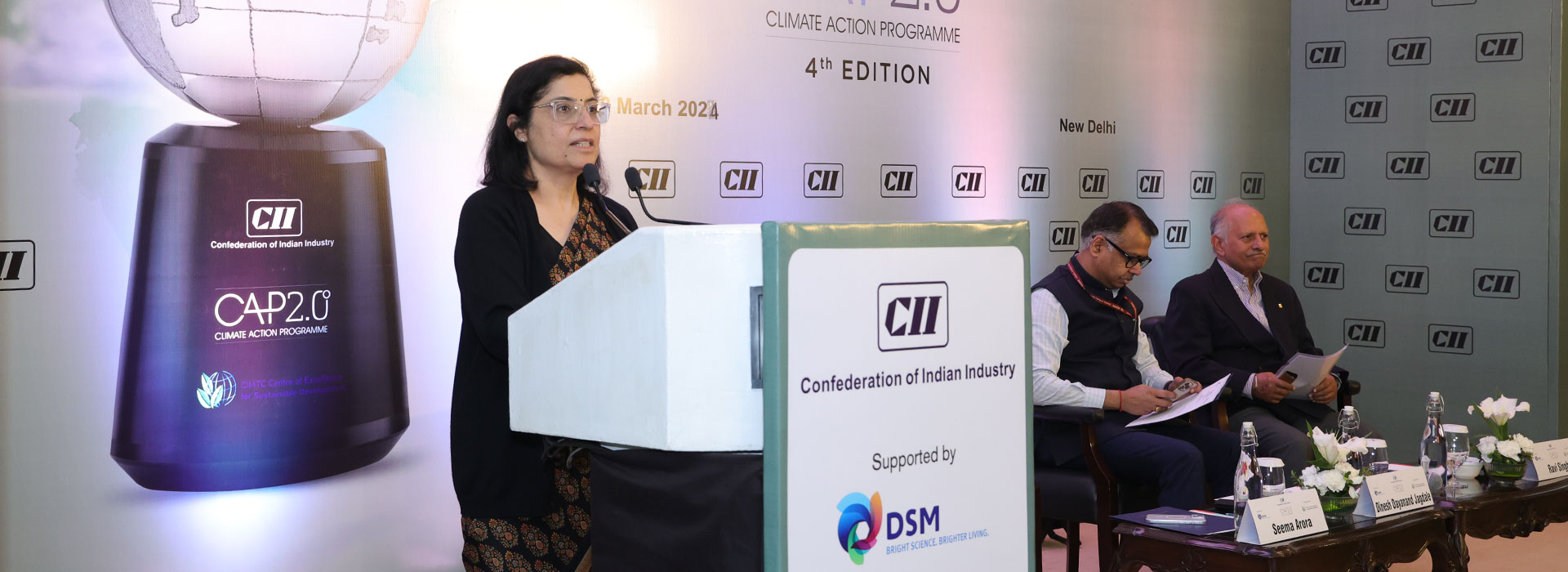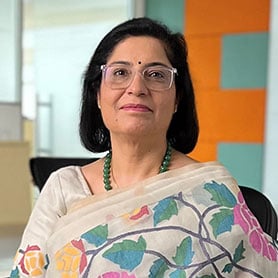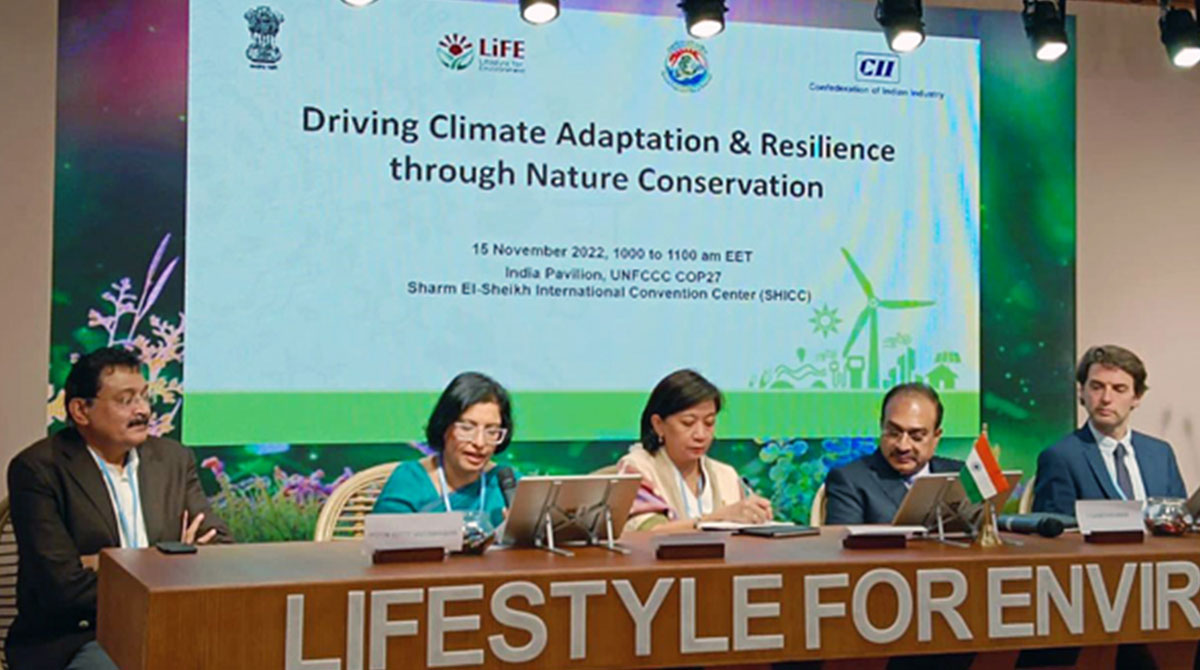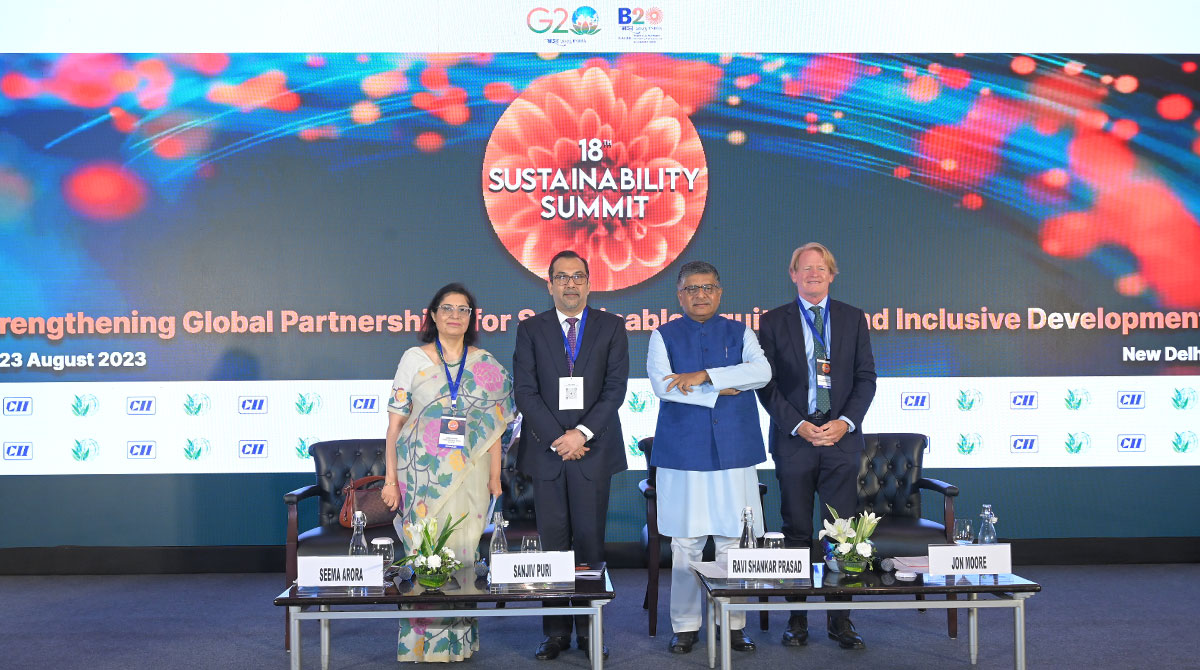Seema Arora: Driving Sustainable Development
With over three decades of experience, Seema is a renowned expert in environmental management and sustainable development in India. She collaborates with industry, government, and community-based organisations to develop policy instruments, curate collaborative initiatives, and advise the government on low-carbon growth strategies and sustainable development action plans. Seema’s multifaceted contributions make her an invaluable asset in advancing sustainability across sectors and stakeholders.


Ms. Seema Arora
Deputy Director General,
Confederation of Indian Industry (CII) and
Member of the dss+ Impact Advisory Board
Q.
Tell us about your professional journey into leadership roles and what shaped your chosen career path.
My journey into leadership roles has been shaped by a blend of diverse experiences and a passion for driving positive change. Graduating as an Engineer, I embarked on my professional voyage at the Shri Ram Group, gaining exposure across various business functions. While I found fulfilment in these roles, I yearned for something more intellectually stimulating.
This led me to the Confederation of Indian Industry (CII) in 1991, where I initially joined as an Executive Officer tasked with overseeing the Energy and Environment Committees. It was during this time, amidst the run-up to the 1992 Rio Earth Summit, that I received a crash course in sustainable development. Collaborating closely with industry stalwarts and global leaders such as Mr. Hugh Faulkner, Mr. Maurice Strong, Mr. Ratan Tata and others, I became deeply involved in shaping CII’s agenda on sustainable development, laying the foundation for what would become my life’s work.
Transitioning from being a key contributor to assuming leadership responsibilities in 2006 marked a significant milestone in my career trajectory. The pivotal decision to transform our vertical into a Centre of Excellence propelled me into a leadership role where I led a team of domain experts in driving thought and actions in sustainability. Since then, I have embraced various leadership roles within the organisation, fuelled by a continuous commitment to leveraging my expertise for the greater good. This journey has not only been professionally rewarding but has also reinforced my belief in the power of collaborative action to affect meaningful change.
Q.
As Deputy Director General of the CII and a dss+ Impact Advisory Board Member, you hold influential positions in both the public and private sectors. How do you navigate the intersection between these two spheres to drive sustainable development initiatives effectively?
I navigate the intersection between the public and private sectors by balancing the interests of diverse stakeholders while driving sustainable development initiatives effectively.
At CII, we represent members from both the public and private sectors, advocating for policies that prioritize the nation’s well-being above individual interests. We adhere to a mantra where national interests take precedence, followed by industry growth considerations, sectoral perspectives, and finally, individual organisation interests. This hierarchical approach ensures that our advocacy efforts are aligned with the collective welfare of all stakeholders, encompassing society at large.
We also facilitate consensus-based decision-making through our Committees and Councils, ensuring that all perspectives are considered, from sector-specific concerns to broader societal implications.
Overall, our advocacy efforts are guided by a commitment to collaborative decision-making, science-based analysis, and a holistic consideration of national, industry, and societal interests. This approach enables us to navigate the complex intersection between public and private sectors effectively, driving sustainable development initiatives that create positive impacts for all stakeholders.
Q.
With over 30 years of experience in the field, how have you seen the conversation around sustainability and climate action evolve within the Indian industry? What are the key changes you’ve observed?
Over the past 30 years, I’ve witnessed a significant evolution in how the Indian Industry perceives and acts on sustainability and climate action. Initially, Industry viewed environmental issues merely as regulatory burdens. However, by highlighting the operational and financial benefits of sustainable practices, CII shifted the conversation towards operational efficiency and the business case for sustainability.
Subsequently, we urged organisations to integrate sustainability into their long-term strategies and business models. This involved assessing the entire value chain through a sustainability lens. In recent years, the dialogue has progressed towards collaboration and collective action. Recognising the scale of global challenges, initiatives such as the India Plastic Pact and the India Business Biodiversity Initiative exemplify the power of multi-stakeholder partnerships in driving systemic change and creating impactful outcomes.
Overall, the journey has seen a transition from regulatory compliance to operational efficiency, strategic sustainability, and collaborative impact, signifying a fundamental shift in how Industry approaches sustainability in India.
Q.
The India Business and Disability Network is a particularly innovative initiative aimed at promoting inclusivity within the corporate sector. Can you share some successes and challenges you’ve encountered in advancing disability rights and inclusion through this platform?
Establishing the India Business Disability Network (IBDN) was a pivotal, yet challenging endeavour aimed at fostering collaboration between industry and civil society to promote disability inclusion. Convincing stakeholders to prioritize inclusivity over individual agendas was the initial hurdle. However, by emphasizing the shared goal of enhancing opportunities for persons with disabilities, we fostered a collaborative spirit.
One major challenge was the mismatch between the demand for skilled workers with disabilities and the available talent pool. To address this, we organised job fairs and implemented mentoring programs, bridging the skills gap, and empowering individuals with disabilities.
Furthermore, we focused on showcasing the business case for disability inclusion through sector-specific case studies, encouraging Industry to view it as more than just a CSR initiative but as a strategic advantage.
However, significant challenges remain, particularly in addressing multiple disabilities beyond physical impairments. Despite these obstacles, international collaborations have enriched the network, enabling knowledge sharing and innovative solutions. The strength of the IBDN lies in its collaborative ethos, driving progress towards greater disability inclusion in the corporate sector.

Q.
With the increasing urgency of climate change, there is growing pressure on businesses to adopt sustainable practices. How do you advocate for corporate buy-in to sustainability initiatives, particularly in industries that may be resistant to change?
Advocating for corporate buy-in to sustainability initiatives, especially in resistant sectors, requires demonstrating both the risks of inaction and the opportunities for positive change. We emphasize the business case for sustainability, highlighting potential risks such as regulatory non-compliance and market shifts due to changing consumer preferences and government procurement policies.
Moreover, we showcase the opportunities associated with sustainability, such as accessing new markets for green products and gaining competitive advantages as early adopters of environmentally friendly technologies. For instance, sectors such as steel and automotive can tap into emerging markets for green steel and electric vehicles, respectively.
However, securing buy-in from MSMEs poses unique challenges due to limited awareness and resources. Our approach involves generating awareness, building capacity, and providing financial support through policy advocacy, education, and access to funding mechanisms.
Ultimately, our task is to educate and empower Industry to embrace sustainability as a strategic imperative, leveraging tangible outcomes and global trends to drive meaningful change.
Q.
In your role as a leader in sustainable development, how do you balance the need for short-term economic growth with long-term environmental sustainability?
Balancing short-term economic growth with long-term environmental sustainability is akin to managing a diversified investment portfolio. Just as we allocate funds for immediate needs and long-term goals, sustainability requires actions that yield both immediate benefits and future resilience.
We must leverage today’s actions to generate resources for future investment in sustainability. This may involve adopting innovative approaches such as internal carbon pricing models or reimagining business models to embed sustainability principles.
The key lies in finding the “sweet spot” where current investments yield returns that can be reinvested in both present and future sustainability initiatives. It’s a strategic balancing act, similar to financial planning, where we allocate resources wisely to achieve both short-term gains and long-term resilience.
Q.
Your involvement in policy development suggests a keen understanding of the regulatory landscape surrounding sustainability. How do you engage with policymakers to advocate for policies that support sustainable business practices?
Engaging with policymakers to advocate for sustainable business practices is a central aspect of our work. We collaborate with government bodies to shape policies that foster sustainability across various sectors, from renewables to resource efficiency.
Our approach involves both long-term strategic planning and addressing immediate challenges. We provide policymakers with sector-specific roadmaps for transitioning to sustainable practices and advocating for the necessary regulatory frameworks.
Furthermore, we work to solve current compliance issues faced by Industry, ensuring that policies are practical and actionable. This involves gathering input from our extensive network of members and officers, and advocating for changes that enable Industry to exceed compliance standards.
While progress is evident at the national level, we also focus on addressing challenges at the regional level to ensure uniform progress nationwide. Additionally, we advocate for a level playing field, striving to empower all stakeholders, including those with limited access to resources.
Our advocacy efforts extend beyond policy development to encourage proactive business actions. We urge organisations to take voluntary steps towards sustainability within their value chains, complementing government initiatives.
Overall, our approach involves multi-faceted advocacy, combining policy engagement with encouragement to Industry to drive sustainable practices at all levels.

Q.
As you know, this interview is part of a series called “Leaders Making a Difference.” What would you say you’re most proud of in terms of your leadership?
What I’m most proud of in terms of my leadership is my contribution to the shift in the discourse surrounding sustainability. The consistent advocacy has helped in changing the way Industry views sustainability - from merely focusing on compliance and regulations to emphasizing efficiency and strategic thinking.
This shift has been incredibly satisfying for me, as it represents a game-changer in how we approach sustainability. Over my 32 years with the organisation, I’ve been part of taking the conversation beyond individual organizations to highlight the collective impact we can make collaboratively. There is an understanding now that it’s not just about benefits to the organization but also how can the actions positively impact the broader community and stakeholders.
For me, true impact lies not only in charity or CSR but in leveraging the business operations to create meaningful change. This involves innovating new models of service delivery that are efficient, sustainable, and inclusive. Over the past five to six years, we’ve begun this journey, and I’m excited to continue scaling these efforts to bring sustainability, inclusion, and economic growth to all segments of society.
Q.
Given your experience as a mentor, can you share three suggestions for someone just starting their career in the field of sustainability?
For someone just embarking on their journey in sustainability, I would emphasize three key principles. Firstly, adopt a mindset of perpetual learning, acknowledging that each day presents an opportunity for growth and insight in this dynamic field. Secondly, maintain a balance between passion for your ideas and receptivity to critique, recognizing that innovation often arises from constructive challenge. Finally, dare to break from conventional thinking and embrace innovation, understanding that progress often stems from daring to explore uncharted territories. By embodying these principles, one can navigate the complexities of sustainability with resilience, adaptability, and a commitment to positive change.